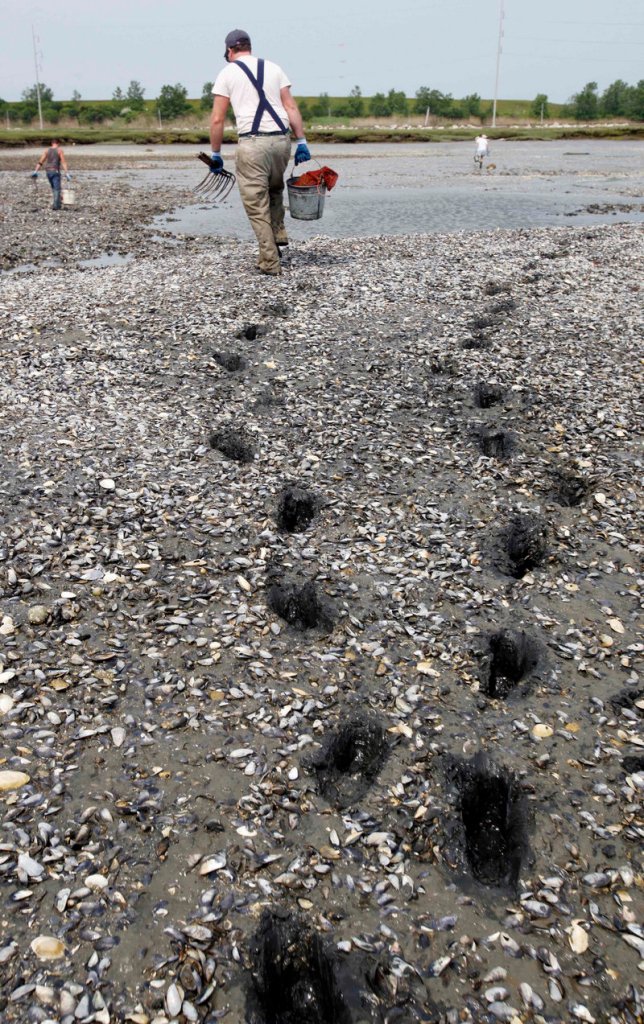BOSTON – A gray muck swallows their boots as they dig into it, snatch clams from between cracked shells and sea worms, then crouch low to do it again. It’s unforgiving, often dreary work, and all these local clammers want is the chance to keep at it.
But they say pending safety upgrades to the runways at Logan International Airport will claim important shellfish beds and nursery grounds and kill an industry segment that’s already staggering from a recent die-off of the soft-shell clams they uncover.
John Denehy, head of the Boston Clammers Association, said the airport’s manager — the Massachusetts Port Authority — is moving ahead with no regard for whether the 30 or so Logan diggers survive the changes.
He said there’s no talk of money to make up for the lost business. And though Massport plans to relocate the soon-to-be-lost wetlands, the areas it is discussing are either too far away or no good for clamming, Denehy said.
“They believe they’re bigger and stronger than we are, and they’re just going to overwhelm us,” said Denehy, 39. “We’re going to fight them to the last clam, and we want them to know that.”
Massport spokesman Matthew Brelis said the agency, in fact, values the clammers as another “set of eyes and ears” to boost security around the airport.
He added that the clammers have been consulted about the crucial safety upgrades, including during a March meeting, and there was a public comment period before permits were issued in April.
And Brelis said nothing is final about the new shellfish beds: Discussions are ongoing with the state Division of Marine Fisheries about what Massport will pay to establish them. Any new shellfish beds, though, can no longer be located close to airports due to Federal Aviation Administration guidelines, he said.
“Shellfish attract birds. Birds are a hazard to aircraft,” Brelis said.
Logan’s clammers have taken on Massport before, when they were shut out of the land for security reasons after the Sept. 11 terror attacks were launched from the airport.
Fourteen months later, the clammers returned to Logan’s prolific flats after persuading state lawmakers to pass regulations allowing them back under tighter screening, including background checks and fingerprinting.
The coming $70 million safety upgrades are required by the FAA to improve two so-called runway safety areas, which include granite fill and sections with collapsible concrete blocks to slow or protect airplanes that overshoot or undershoot the runway.
The expansion takes away 62,370 square feet of shellfishing at the end of one runway, 22R, and about 5,400 square feet at the end of runway 33L, according to a final environmental impact statement. The area at the end of 33L is scheduled to be closed next month; the end of 22R will shut down in two years.
Denehy said both areas are crucial to the local industry’s future, especially after local clammers were whacked by an unexplained die-off of soft-shell clams at Logan’s most productive flats.
The clammers blame an October 2010 jet fuel spill by cargo and baggage handler Swissport, saying it’s no coincidence live clams disappeared shortly afterward. But Brelis said that’s doubtful.
“Because only one species (soft-shell clams) was affected, it is likely that a virus was the cause rather than petroleum contamination,” he said.
Massport owns the land around the airport up to the high water mark, but the public has the right to dig beyond that, Denehy said.
Copy the Story Link
Send questions/comments to the editors.



Success. Please wait for the page to reload. If the page does not reload within 5 seconds, please refresh the page.
Enter your email and password to access comments.
Hi, to comment on stories you must . This profile is in addition to your subscription and website login.
Already have a commenting profile? .
Invalid username/password.
Please check your email to confirm and complete your registration.
Only subscribers are eligible to post comments. Please subscribe or login first for digital access. Here’s why.
Use the form below to reset your password. When you've submitted your account email, we will send an email with a reset code.